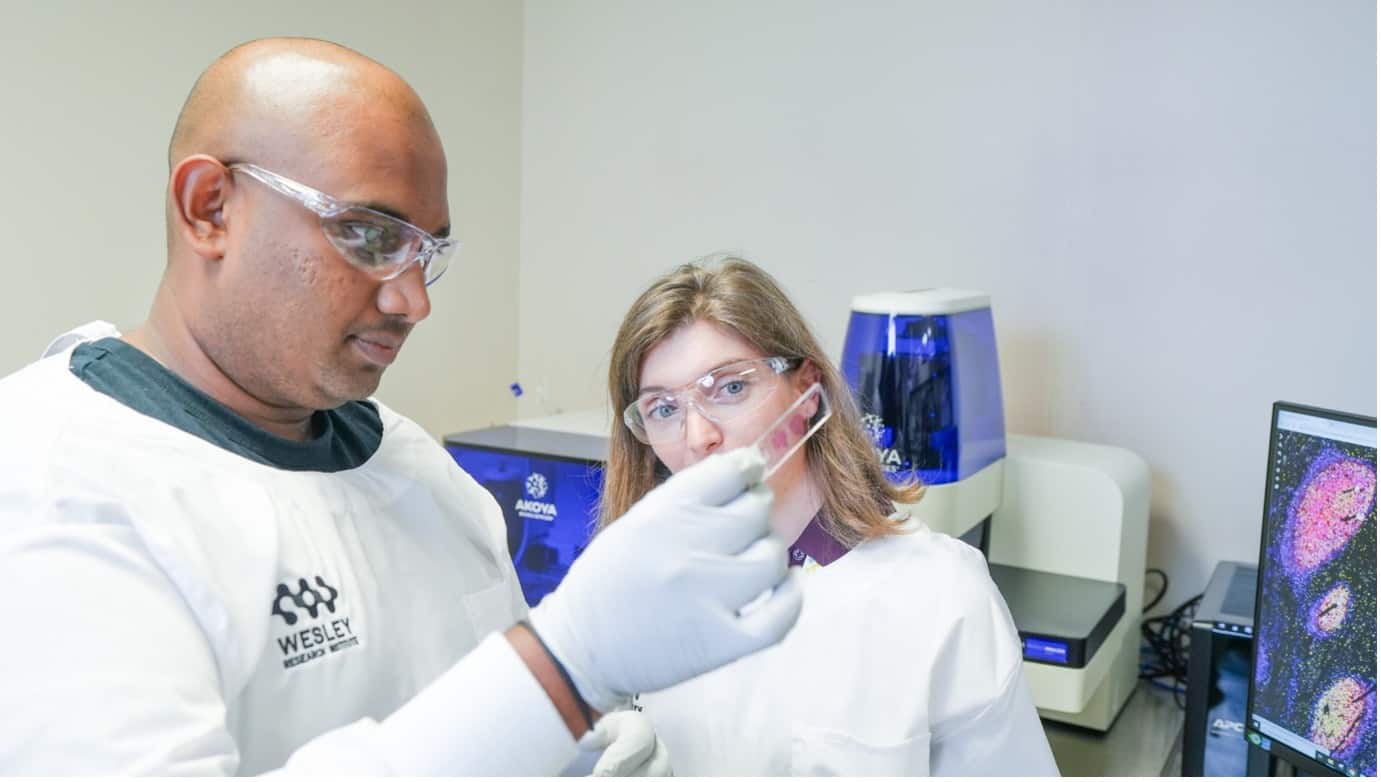
Queensland researchers have unveiled a pathology breakthrough that reveals how individual cells interact and in turn maps a pathway for highly personalised treatments for some of Australia’s most lethal diseases – cancer, heart and lung disease.
Professor John Fraser, Clinical Director of the Wesley Research Institute’s new Queensland Spatial Biology Centre (QSBC), where the research is being conducted, said the cutting-edge approach uses advanced spatial mapping technology and digital pathology tools to revolutionise the way clinicians understand and combat a range of life-threatening diseases.
“In the future, spatial phenotyping and spatial omics, are terms you will hear a lot more about. They refer to a very new field of biology that analyses the spatial distribution of cells and molecules in biological samples in their specific locations, such as heart or lungs, providing insights into their organisation and interactions, We now have a roadmap for tailored treatments, using this technology, which allows us to tackle one cell, one organ and one disease at a time to improve the health of people grappling with illness.”

Inspiration for the approach emerged from his involvement in the international COVID-19 Critical Care Consortium, funded by the Bill and Melinda Gates Foundation. Despite collecting a significant amount of clinical data on COVID-19 the consortium struggled to understand how different organs responded to the disease.
Collaborating with QSBC co-lead, Dr Arutha Kulasinghe, the duo employed a Google Maps-like approach enabling researchers to visually zoom in and out, and apply layers of filters when analysing tissue samples.
“Our talented QSBC researchers have unveiled a level of insight never before attainable, exposing the behaviour of individual cells and their interactions,” said Professor Fraser.
“In days gone by young kids would sing, ‘...the knee bone connects to the thigh bone...’. Well fast forward to a new millennium with our new technology, and we in Queensland are now leading Australia to see how individual cells connect to each other and how that affects a patient’s disease condition.
“If you imagine each cell being a jigsaw puzzle piece, this new technology allows us to see how each cell fits in with its neighbouring cells – and how various treatments can impact the interaction between those cells for better or worse. We have just jumped light years in terms of diagnosing and observing which treatments will or won’t work.”
Professor Fraser attributed the breakthrough to Dr Kulasinghe’s expertise coupled with the cutting-edge Akoya Biosciences PhenoCycler®-Fusion System, a state-of-the-art machine in spatial omics technology. The pioneering system, the only one of its kind within an Australian hospital, enables spatial phenotyping of countless cells at an unprecedented scale and speed.
“Purchased with more than $600,000 generously donated to the Wesley Research Institute, the PhenoCycler allows our researchers to map millions of cells and their interactions with 150 pathological biomarkers and diseases across a single intact tissue section,” he said.
“The PhenoCycler facilitates the discovery of rare cell types, cellular neighbourhoods and spatial functional states to explain why individual patients have varying degrees of success responding to treatments.”
Dr Kulasinghe, Scientific Director at Wesley Research Institute's QSBC and Group Leader from The University of Queensland’s Frazer Institute, said the transition from traditional pathology methods to this advanced technology marks an important paradigm shift.
“This technology leap is comparable to going from the horse-and-cart to the modern-day electric vehicle,” he said.
“High-speed scanning of tissue samples combined with advanced machine learning and artificial intelligence processing power produce beautiful images of cells that resemble satellite pictures of stars and galaxies in outer space.”
Wesley Research Institute CEO Andrew Barron said the research had the potential to revolutionise treatments across a range of diseases and conditions.
“Initially, we are focusing our limited resources on producing the greatest and most immediate impact by studying the big killers in our society, which are heart, lung disease and cancer,” said Mr Barron.
“We are leveraging Wesley Research Institute’s expertise and unique access to UnitingCare Queensland’s St Andrew’s and Wesley hospitals with world-class clinicians, a large population of patients and Queensland's biggest biobank to equip our small, agile team to make a huge impact.
“Our co-located clinicians, scientists and biomedical engineers are creating medical advancements that offer hope for better patient outcomes.”
Professor Fraser, who is also the Director of Intensive Care at St Andrew’s War Memorial Hospital and Director of the Critical Care Research Group at The Prince Charles Hospital, said the QSBC team had started collaborating on international spatial omics projects with other leading centres including Harvard, Yale and St. Jude Children’s Research Hospital in the United States.
“We are on the cusp of something tremendous. This will change the way we diagnose, and treat cancer, heart and lung disease,” he said.
“Each patient’s tumour is unique, and we need to identify the intricacies in their biology which will aid in personalising therapies for their specific cancer.
“Through research, we are unlocking a brighter and healthier future for those battling these debilitating diseases.”
MEDIA CONTACT: For further information or to arrange interviews with the researchers, contact Director Wings Public Relations Deanna Nott on 0422 504540.
